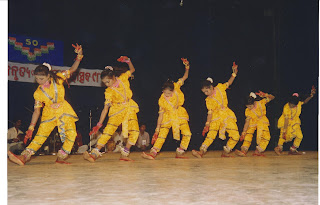SHABDA NRITYA
(DANCE OF SOUND)
Origin: KUMBHARI
District: BARGARH
District: BARGARH
State: ODISHA
Bargarh town is the head quarters of District Bargarh in Orissa. About 21 KM from Bargarh there is a village by name Barpali from where if one travels to about 6 KM reaches KUMBHARI, the birth place of a dance form SHABDA NRITYA.
The village, Kumbhari is also famous for a shrine of BRAJESWARI, the Goddess of BRAJ (BRINDAVAN) wherein a peacock feather is being worshipped as the presiding deity. In the backyard of the temple, BRAJESWARI NRITY KALA SANSAD gives training to male children in Shabd Nritya.
The shrine of Goddess Brajeswari the premises of
BRAJESWARI NRITY KALA SANSAD
Shabd Nritya had its birth at Kumbhari and the training program in the dance form is confined only at Kumbhari as the originators of this dance form had taken an oath before Goddess Brajeswari that they would not expose the dance form to outsiders. Hence to learn the various aspects of this dance one should come and stay at Kumbhari for the training program. Due to this self-imposed restriction, Shabd Nritya which is also regarded as a classical dance, could not get the degree of prominence that this dance form deserves in spite of possessing all the fineries of a classical dance.
Shabd Nritya had its birth about three centuries ago but its time of birth has not been correctly established. Shri. Bansi Prasad was considered as the oldest guru of Shabd nritya. A group of exponents of this dance form such as Bihari Pradhan, Tengunu Pradhan, Vyasdeep Bhoi contributed their might to bring prominence to this classical dance form. To-day Guru Bhagawat Pradhan Bhaga has been trying rather vainly to produce “SHABD” (sound) with a single hand with a hope that someone will lend their helping hand or else Mata Brajeswari herself will protect Shabd Nritya to survive at Kumbhari.
Guru Bhagawat Pradhan Bhaga
Shabd Nritya is performed to invocate Lords Shiva, Ganesh, Vishnu and Goddesses Durga and Kali mata. This is basically a vigorous dance i.e. Tandava style. The dance is performed in four stages starting with Alap (first stage), Swara Nritya (second phase), Shabd Nritya (climax, the third stage) and finally Pallavi Nritya (the normal or initial position, the fourth stage).
The dance is commenced with ALAP with a song to invocate a God or Goddess and the musical instruments provide the Rhythm (LAYA) for the dance. The dance is being performed exclusively by male and 4 or 5 members participate.
Invocation of the Goddess by the Dancers
The musical instruments include:
MARDAL
MARDAL
GINNI (small brass cymbals),
SANKHA (Conch),
DAMARU (a two sided percussion instrument)
GHANTA (a bronze plate)
BANSI or BANSURI (a flute)
JHANJ and
HARMONIUM
.The back ground music is rendered in “trimisra” (.repetition after 3-times.)
In the second phase called “Swara Nritya” main characters such as Shiva, Durga,
Kali, Ganesh or Vishnu enters depending on the theme of the dance number. The dance continues around the central character rather slowly with gentle movements (Lasya style). Different Ragas and Swaras are recited to invocate the central character (God or Goddess). During performance of the dance Triputa tal (7-matra) is most commonly used. The dancers translate the song into a beautiful dance with various Pada ghatanas (foot steps), Hasta mudras (hand gestures) and Mukha mudras (facial expressions)...
SHABD NRITYA
In the third phase called “Shabd Nritya” the dance reaches its climax with vigorous and intricate movements by the dancers. The speed of the song (Bol) and the rhythm provided by the musical instruments are elevated to the peak making the audience spell bound due to excitement. However, the climax cannot be sustained for more than five minutes as the movements are highly vigorous (TANDAVA or UGRA style) and the dancers cannot keep up their pace beyond five minutes.
In the concluding phase of the dance number the dancers come to a subtle or slow state in praise of the God or Goddess. This stage is called “Pallavi Nritya”.
In Shabda Nritya the song is provided in Sambalpuri dialect and for this reason this dance form is particularly popular in the districts of Western part of Orissa such as Sundargarh, Jharsuguda, Sambalpur, Bargarh, Nuwapada, Kalhandi, Bolangir, Sonepur and parts of Devgadh and Koraput.
Shabda Nritya has all the elements to consider it as a classical dance form. It adopts all types of Mudras (hand postures). In “ Padma Mudra” (to show a lotus flower) the size of the lotus(Padma) and the height of the stalk of the flower above the surface of water can also be clearly distinguished adopting different Padma Mudras. In “Deepa Mudra” (indicating oil lamp) different decorations of the lamp is shown by different Deepa Mudras.
As in Gotipua, Shabda Nritya is also performed by male dancers. Although there is no comparison ODISSI, the pride of Odisha predominantly has Vaishnava background and performed by both female and male dancers rather in graceful Lasya style. Shabd Nritya has Shiva-Shakti as background and performed in Tandava style. There is every scope for Shabda Nritya to develop it as another classical dance form of Odisha.
My special thanks are due to Shri.Bhagawat Pradhan Bhaga, the Guru of this dance form for narration and Santanu Biswal, a journalist from Bargarah for accompanying me to Kumbhari. This information was obtained some 10 years ago when I visited Bargarh for ‘Dhanu yatra’, an annual festival of Orissa.
DT: 3-10-2011.
E.Hanumantha Rao,
56-14-5, vidyanagar,
ANDHRA PRADESH
Mail ID: email2ehrao@gmail.com
Mail ID: email2ehrao@gmail.com






No comments:
Post a Comment